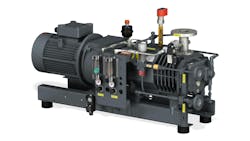Money, Maintenance Main Benefits Of A Dry Vacuum Pump
Jason Stiel, Ph.D., chemical and pharmaceutical sales manager, Busch Vacuum Solutions
Many chemical companies are striving to improve the reliability of vacuum systems, lower total cost of ownership and meet regulatory requirements for emissions standards and noise reduction. To address these demands as well as specific vacuum technology problems, vendors are responding with novel applications of established equipment as well as new technologies.Enter dry vacuum pumps. Chemical Processing chatted with Busch Vacuum Solutions’ Jason Stiel, Ph.D., chemical and pharmaceutical sales manager, about the benefits and challenges of dry vacuum pumps. Busch USA is based in Virginia Beach, Va.
Q. What are the advantages and limitations of a dry vacuum pump?
A. Dry vacuum pumps are versatile. You can manipulate them to do almost anything. There are several technologies available for dry vacuum pumps. For this conversation, I’ll just focus on vacuum pumps using a screw mechanism because I believe that is one of the best technologies out there — especially in the industrial large scale.
The advantage of a dry vacuum pump is the consistent performance. You have the same performance on day 1 as you do on day 100 because you don’t have any fluid that can capture the vapors or vanes that wear down. The vapors typically just pass right through the vacuum pump, as long as they stay in the vapor phase.
In contrast, an oil- or a fluid-sealed vacuum pump tends to trap the harmful gases, which you’re going to have to dispose of in the waste later. This will increase maintenance costs and be a potential health risk to employees. For a dry vacuum pump, the vapors that make it past some type of filter or trap upstream will pass through the vacuum pump and exhaust to atmosphere or an abatement system.
Another benefit of the dry vacuum pump is its very simple mechanism. There are only two rotating components inside of the vacuum pump. This results in lower maintenance and repair costs when compared to the other dry technologies. The screws are non-contacting, so the vacuum performance will not suffer with use. (Oil-sealed vacuum pumps usually have a vane or piston that contacts the sidewalls and eventually wears down. That means maintenance, which leads to parts and labor costs.)
The vibration levels for our dry vacuum pumps are much lower than a piston-style oil-sealed vacuum pump. This can be important for certain processes and instruments that are sensitive to vibration. Dry vacuum pumps cover a wide range of pressures from atmosphere to below 1×10-2 Torr. Compare this to an industry staple, the liquid-ring vacuum pump, which is limited to 25 Torr with water as a seal fluid; so, you can see there is more flexibility.
As for limitations, sometimes the upfront cost does not seem justified or there is a technology that is better suited for the application. If you’re operating in a higher pressure range — above 100 Torr — and you’re dealing with a concentrated vapor stream, it may be better to use a liquid-ring vacuum pump. Some processes in which sticky materials make it into the vacuum equipment, an oil sealed vacuum pump like our HUCKEPACK will be simpler to use. We work around these limitations with the use of different traps, flushes, and automation, but it’s an inherent advantage that sometimes the oil-sealed vacuum pumps will have.
In terms of cost, the prices have come down since we developed the first screw vacuum pump in 1991, but now it’s only a difference of maybe 20% more for a dry vacuum pump.
Q. How can an engineer justify the cost of a dry vacuum pump?
A. The slightly higher price can be justified through lower maintenance, waste management, utility and labor costs. You will have to dispose of the large amounts of consumed oil that oil-sealed vacuum pumps require. This can add up quickly when compared to oil vacuum pumps with 15 gallons of oil. The dry vacuum pump's rotational speed can typically be reduced when not in use and the water is only used to cool the vacuum pump, which leads to utility savings. We also have air-cooled dry screw vacuum pumps in several sizes to save on water costs. For example, we have a customer who wants to save money on utilities in general. So, we did a cost analysis for them where they have a very efficient single-stage rotary vane vacuum pump, but it was not in demand constantly. However, they needed to have it ready to run, so they leave it running.
You can use a variable frequency drive (VFD) to slow these vacuum pumps down. For a wet vacuum pump, you could slow it down to maybe 40 Hz com-pared to the 60 Hz. The dry vacuum pumps can be slowed down to about one-third of the initial speed, which saves on energy cost.
For this customer, by slowing down this one vacuum pump package with our dry technology, we would be able to save them $20,000/year. If you couple that with multiple oil changes per year, waste disposal and labor hours, the cost will offset quickly. It can be pretty simple to justify, depending on different applications.
Q. When and why is the dry vacuum pump preferable to a wet vacuum pump?
A. There are several different applications. Focusing on the chemical market, the dry vacuum pumps can be used for most instances: distillation, evaporation, degassing, freeze-drying, sublimation, etc. Dry vacuum pumps are great for processes that you don’t want oil backstreaming (i.e., when oil from the vacuum equipment travels against the process stream and contaminates the process chamber). That can be a real problem, especially in the pharmaceutical industry or if your product needs to be extremely pure.
It’s also preferable in different harsh processes. If you’re removing acid vapor from your process, that acid vapor can get into your oil and cause the oil to fail prematurely. There are processes where the vapors can cause the oil to rubberize. You can use a fully fluorinated oil, which is extremely expensive, to have an inert oil. In this case, the cost can be justified very quickly because you’ll make it up almost after the first oil change.
Q. What factors are more important when using a dry vacuum pump than a wet vacuum pump?
A. One of the most important considerations I would say for a dry vacuum pump is startup and shutdown. In most of the manuals, startup and shutdown is the same for wet vacuum pumps, but people don’t follow it and it’s not as crucial. But it is extremely crucial in dry vacuum pumps. You want to make sure you allow the equipment to warm up so that the design tolerances of the screw mechanism are optimum. It usually takes 10 minutes and then the vacuum pump is ready to go.
The shutdown is even more crucial. You want to make sure you follow what the manual recommends for shutdown such as isolating the vacuum pump and purging the swept volume with nitrogen or clean dry air of any condensable vapors, typically for 20–30 minutes. If condensable vapor remain inside the vacuum pump, the metal material of construction will begin to erode. Even though we offer protective coatings on our screws, proper shutdown procedure is necessary.
Additionally, we recommend you have a power failure mode. A normally closed inlet isolation valve and a normally open purge valve just below it should help to protect the vacuum pump. This equipment protection feature isn’t implemented by a surprising number of plants.
It is important to protect your investment by having filters or traps in front of the dry vacuum pump. While they can take slugs of liquid, it’s always important for any technology to have a knock-out pot if this is a possibility. Typically, a dry vacuum pump can ingest a liter or so of liquid without it be-ing an issue, but you don’t want to send 20 gallons to it. Any vacuum pump is going to have a hard time with that. We can use this ability to ingest liquids and do a solvent flush to clean the swept volume. For the most efficient cleaning, you should slow the vacuum pump down with a VFD and then draw in the solvent of choice. This allows you to remove all of the gummy material from the screws.
Q. Are there any other special design considerations?
A. There aren’t any necessarily unique to dry vacuum pumps versus wet vacuum pumps. You want to eliminate as much pipework as possible because you want to limit conductance loss through bends and long pipe runs. And then, you want to make sure your exhaust is clean and clear because vacuum pumps, in general, don’t like having too much back pressure. Check valves are recommended to prevent reverse rotation and contamination from exhaust pipework, especially when multiple exhausts are connected to the same header.
With dry vacuum pumps, if you exceed the back pressure limit, this will cause undue stress on the motor and elevated internal temperatures. The increased temperature leads to excess metal expansion and, ultimately, the seizure of the vacuum pump. Our design is more tolerant than most. Typically, the industry average is around 2 psi for continuous use. Ours is at 3 psi, which doesn’t sound that significant but is — we have some room to give, especially with people who are trying to push their process to an abatement system that can provide some back pressure.
Q. Any advice on how to decide which vacuum pump is appropriate?
A. There are so many different applications. What I would always recommend is talking to a vacuum expert. At Busch Vacuum Solutions we have a lot of experience — we’ve been doing this for over 50 years. We want be part of the solution.
We are an engineering group as well, so we can design a complete vacuum solution. Talk with the vacuum experts and see what we have to say. We will come up with a great solution for you and work with you to make sure we’re offering the right option.
That’s the benefit of working with a family company like Busch. We try to extend that family feel to our customers.


